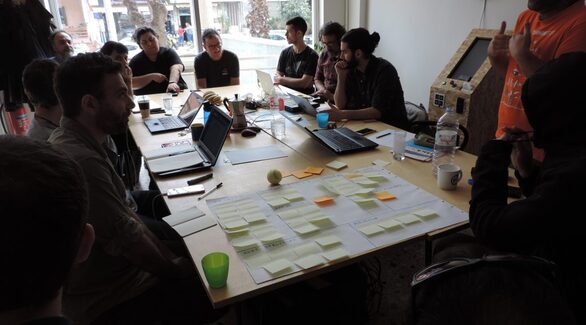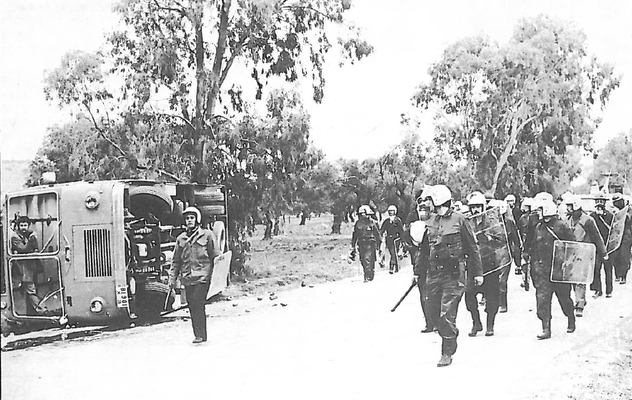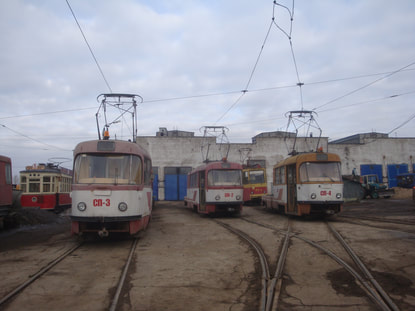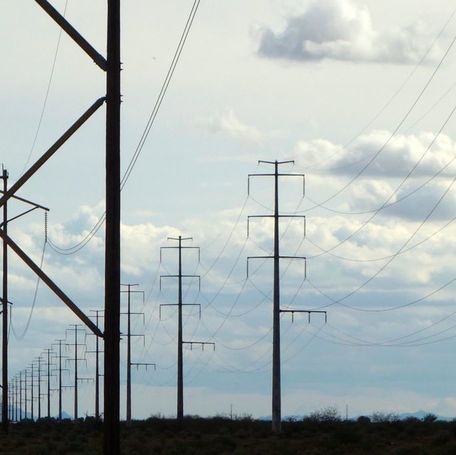|
By Christos Giovanopoulos,
infra-demos member & PhD candidate in Anthropology, Vrije Universiteit Amsterdam The latest version of CommonsFest in Heraklion, Crete (Greece) took place on the weekend of 30 & 31 March and 1 April. infra-demos took active part in the organization and funding of the festival. CommonsFest has been an annual action to promote open source knowledge and P2P cooperation for the development and management of the commons that runs since 2013.This year the three-day event focused on the creation of common(s) structures for the advancement and support of sustainable cooperative schemes and enterprises. The meeting aimed to detect and display the potentialities of the cooperative model of work as a viable form of professional enterprise. One that combines the inclusion of everyone in the labor market without exclusions while it develops a model of democratic self-management and producers’ autosuggestion. A diverse eco-system More than twenty-two collectives active on the field of cooperative and solidarity economy and the commons throughout Greece presented their work (full programme) manifesting a vibrant and advancing activity in a wide range of fields, from digital technology to agriculture. Cooperative schemes such as Ο.Σ.Η. (Integral Cooperative of Heraklion), Terra Verde and Fruits of Solidarity presented their work on developing unmediated (producer to consumer) networks of food distribution, both on a local and on cross-national levels. C-Hub Athens and common/space presented their efforts to address issues as housing and the production of urban infrastructures and space as commons and through participatory practices, while the Elektra Energy cooperative spoke of their work on assisting the creation of energy (users’) communities. In addition the, pioneering and well known, Sarantaporo.gr updated on their autonomous wireless communication network (going since 2013) that brought internet connection to the residents of 11 isolated from the grid villages in the mountainous Sarantaporo area of Elassona (central Greece). One also has to underline the presence of Εφημερίδα των Συντακτών (Newpaper of its Writers), the only cooperative daily paper in Greece with national distribution, which runs since 2012. Of course, in such a meeting significant it was the presence of numerous tech-cooperatives and hacker communities in Greece. Collectives which have been in the frontline of promoting and producing open source tools for more than a decade, and younger ones’ created in the period of the crisis. The makerspace Commonslab has been one of the initiators and hosts of CommonsFest in Heraklion where it is based. Hackerspace has been another significant community in open source technologies in Greece and internationally, which participated along with other cooperatives such as the open.tech, foss.office, Στην πρίζα (translates “in the socket”) and Sociality. Last but not least a variety of research projects related with the development of digital open source and participatory infrastructures complete the picture of the participants. Infra-demos was one of those projects next to the internationally established P2P Lab, to Newcastle university related Open-Lab Athens and to the Zurich based non-profit research group NetHood. Results CommonsFest by bringing together practitioners, activists, researchers and communities on the fields of open source technologies, cooperativism, solidarity economy and the commons, managed for one more year to become a creative and inspiring hub. However, this year the occurring knowledge exchange and collaborative atmosphere had some tangible results. In the framework of CommonsFest a parallel process for the creation of a Collaboration for Open Technologies took place, with the participation of 9 collectives, Infra-demos among them. The outcome has been a first public statement regarding the will and objectives of this ongoing process. Those are discerned in two pillars. The first relates to the development of a collaborative network among tech-cooperatives in order a. to upgrade their operational capacities aiming to enhance their sustainability and b. to develop and promote more efficiently open source and collaborative mode of technologies among the social solidarity economy entities. The second regards the creation of research actions and collaborations for the advance of the urban movements, cooperative forms of economy and (practices and infrastructures of) the commons. The entire process manifests the potential for the emergence of participatory and collaborative modes of techno-social infrastructures which infra-demos tries to bring to light. Moreover, by being organic part of these developments infra-demos practices from the outset an engaged and participatory research methodology, as a constituent element for/of the design of open to citizens and communities (needs and skills) infrastructuring and infrastructural transformation.
4 Comments
By Dimitris Dalakoglou & Yannis Kallianos
Anthropology touched upon infrastructures and their theoretical potentialities for the discipline in the 1960s and 1970s (Harris 1968; Godelier et al. 1978). Although the anthropological approach to infrastructures has always been distinct, these first infrastructural perspectives still drew upon the classical materialist social theory. As a result of this genealogy, infrastructures have commonly been considered, within social sciences, to be primarily connected to the material, economic and political spheres, rather than to the social one. This ‘anti-social’ understanding is reflected in ideas about infrastructures as stable and neutral technological systems leading to an everyday experienced normality that is so prevalent in the European infrastructural ideal. However, what the ethnographic approaches to infrastructures of recent years are showing is that if such ideas are ever relevant, they are mostly relevant in very few contexts, usually among the privileged global classes or in places with explicit infrastructural fetishism like post-socialist frameworks (Simone 2004; Edwards 2003; Larkin; Dalakoglou and Harvey 2014). In places where people are experiencing disruptions in infrastructural networks, infrastructures are much more ‘visible’ and are perceived as social and much less neutral technological elements (Dalakoglou 2009; Chu 2014; Dalakoglou and Kallianos 2014). At the other end, more recent work suggests that lack of reliability is always embedded in infrastructures (Dalakoglou 2009; Soppelsa 2009), yet it often just becomes more apparent during times of crisis. The fragility that characterizes infrastructures is also reflected when, for example, one studies ethnographically the people behind the production of infrastructures, such as engineers, as they almost always take the unreliability of infrastructures as a given element of the process (Harvey and Knox 2011). Indeed, one could argue that such practices could potentially simply be ‘black-boxing’ by experts and specialists in an antagonistic relationship between technology practitioners and politicians on the one side, and common people on the other (Star and Bowker 2006). However, these roles of expertise might be imaginary, as it is not a rare phenomenon for the experts to be absent from the actual production and daily function of infrastructure systems, which instead function thanks to the work of mundane low-rank, skilled or unskilled agents (Dalakoglou and Kallianos 2014; Dalakoglou and Kallianos. Forthcoming). All the above echoes a relatively banal but relevant statement: infrastructures are socio-technologicalelements that tend to embody ‘congealed social interests’ (Graham and Marvin 2001; Graham 2010). Although it is a cliché, if this statement becomes a parameter for the approach of IG, a unique window to a major theoretical paradigm shift is opened. Within this context—to put it schematically—soft and hard infrastructures do not produce socio-cultural superstructures, but socio-cultural superstructure produces infrastructural formations. So what are primarily social processes such as sharing, peer-to-peer production, ideas of the commons and solidarity are becoming the new force behind the organization and function of novel forms of infrastructures. Nevertheless, things are complicated. Such an approach to an extent attempts to turn the classical materialist scheme on its head, and opens up a series of very crucial questions that need to be answered. For instance, what are the relationships between soft and hard infrastructures under current circumstances, and what can we potentially learn about covering the IG of hard infrastructures by the way that soft IG is covered? This also opens up to potentialities of a new radically different definition of infrastructures which needs to study and take into account at least two parameters which mutate infrastructure during the crisis in Europe: first, as realms of social and political contestation—with a focus on hard infrastructures within the context of crisis, economic meltdown and political implosion; and second, as sites of socio-technological innovation with the potentiality of articulating new and alternative governance and socio-economic networks focusing on grassroots structures and self-organized initiatives. For the first time in recent Western history, we are also witnessing the pragmatic and theoretical potential of infrastructures not only to be run by the people themselves, but to become a new type of socio-centric, socio-technological hybrid forums and agoras (Callon, Lascoume, and Barthes 2001). Bibliography Callon, Michel, Pierre Lascoumes, and Yannick Barthe. 2009. Acting in an Uncertain World: An Essay on Technical Democracy. Cambridge, MA: MIT Press. Chu, Julie Y. 2014. "When Infrastructures Attack: The Workings of Disrepair in China." American Ethnologist 41(2): 351-367. Dalakoglou, Dimitris. 2009. An Anthropology of the Road. PhD thesis, University of London (UCL). Dalakoglou, Dimitris, Penny Harvey, and eds. 2014. Roads and Anthropology. London: Routledge. Dalakoglou, Dimitris, and Yannis Kallianos. 2014. "Infrastructural Flows, Interruptions and Stasis in Athens of the Crisis." City 18(4-5): 526-532. doi: 10.1080/13604813.2014.939473. Dalakoglou, Dimitris., and Yannis Kallianos. Forthcoming. “Rethinking Infrastructures.” Article under progress. Edwards, Paul N. 2003. “Infrastructure and Modernity: Force, Time and Social Organization in the History of Sociotechnical Systems.” In Modernity and Technology, eds. Thomas J. Misa, Philip Brey, and Andrew Feenberg, pp. 185-225. Cambridge, MA: MIT Press. Godelier, Maurice, Maurice Bloch, Henri JM Claessen, David D. Gilmore, Oriol Pi-Sunyer, and Zoltán Tagányi. 1978. "Infrastructures, Societies, and History [and Comments]." Current Anthropology 19(4): 763-771. Graham, Stephen, ed. 2010. Disrupted Cities: When Infrastructure Fails. Routledge. Graham, Stephen, and Simon Marvin. 2001. Splintering Urbanism: Networked Infrastructures, Technological Mobilities and the Urban Condition. Psychology Press. Harris, Marvin. 2001. Cultural Materialism: The Struggle for a Science of Culture. AltaMira Press. Knox, Hannah, and Penny Harvey. 2011 "Anticipating Harm: Regulation and Irregularity on a Road Construction Project in the Peruvian Andes." Theory, Culture & Society 28(6): 142-163. Larkin, Brian. 2013. "The Politics and Poetics of Infrastructure." Annual Review of Anthropology 42: 327-343. Simone, AbdouMaliq. 2004. "People as Infrastructure: Intersecting Fragments in Johannesburg." Public Culture 16(3): 407-429. Soppelsa, Peter S. 2009. The Fragility of Modernity: Infrastructure and Everyday Life in Paris, 1870-1914. PhD Dissertation, University of Michigan. Star, Susan Leigh, and Geoffrey C. Bowker. 2010. “How to Infrastructure.” In Handbook of New Media: Social Shaping and Social Consequences of ICTs, pp. 230-245. London, Thousand Oaks, CA: SAGE. By Yannis Kallianos & Dimitris Dalakoglou
Imagination is an essential aspect of the experience of infrastructure. Imagining infrastructures has proven to be as important as the actual material state of these objects, systems, and networks. Imagination and infrastructures are so closely linked that Adeline Masquelier (2002) employed the term ‘mythography’ in order to talk about the ways in which local communities in Africa imagined the new roads. Even at the heart of North-Western Europe, ethnographic findings have led the ethnographer to invent the concept of ‘imagineering’, combining engineering and imagination in order to talk about new infrastructural (im)materialities between Denmark and Sweden (Löfgren 2004). South Eastern Europe is no exception to that rule as highways, for example, along the Albanian-Greek borders facilitate the international flows, but also the local and the official state-run imagination (Dalakoglou 2009; 2010). In this discussion Arjun Appadurai’s (1996: 31) view on imagination as a collective process that is founded on the everyday experience as a ‘culturally organized practice’ is instructive. According to Appadurai (1996: 31), imagination ‘is now central to all forms of agency, is itself a social fact, and is the key component of the new global order.’ It can then be argued that the imaginary is closely related to morality, since it entails the question of how to live together in society. This is particularly relevant to our argument that touches upon the idea that past and present politics of infrastructure, as well as sociotechnical imaginaries of future forms of infrastructural technology, reflect ideas and meanings of how people make sense of their position in the social field. This is as much a collective process as a public one. Stemming from the position put forward by Alev Çinar and Thomas Bender (2007: xiii) who argue that ‘the making of a collective imagination is a public process’, moreover the formation of infrastructural imagination to pass through various different operations, from the legal and the institutional to the cultural and the violent. It is for this reason that our examination of the infrastructural codifications of civic engagement in times of crisis entails the use of infrastructure as our concrete epistemological basis through which the current crisis can be explored. What does it mean, then, to approach the crisis infrastructurally? In infra-demos, we engage with this inquiry through the notion of ‘disjunctive modernization’. As we have argued elsewhere, in the case of the waste management of Athens (Dalakoglou and Kallianos 2014), the great majority of Athenians have no idea what happens in the landfills to which their rubbish goes. This is completely contrary to the experience of those in the Fylis region who live next to the facilities; here, their everyday life is defined by what Paul Dourish and Genevieve Bell (2007: 416) call the ‘infrastructure of experience’, the ways in which infrastructure re-emerges as a visible component based on ‘our increasing dependence upon it for the practice of everyday life’. Similarly, experiencing the effects of the invisible infrastructural dimensions, such as buried pipelines and cables, the remote or hidden aerials etc., is often also made sense of through imagination rather than actual direct tangible experience. What is already well established is that when infrastructures break down or pause or act disorderly their presence – including their invisible elements – is sensed via the discontinuity and disruption of the flows that they are supposed to deliver (Humphrey 2003; Star 1999; Graham and Thrift 2007; Graham 2010). Thus, the implication of our previous work (Dalakoglou & Kallianos 2014; Dalakoglou 2017) and of the current project is that even when people come into contact with the infrastructural materiality, or the potentiality of such materiality, imagination still plays a major role in the ways that people know, engage, and understand infrastructures. What has taken place in the times of crisis, then, is the unraveling of Greece’s ‘disjunctive modernity’ – generated by the selective infrastructure development to employ neoliberal economic policies and an assembly of crypto-colonial regimes (Herzfeld 2002), which have come together to shape the everyday urban infrastructure experience. Though diverse, the cases examined in infra-demos, share a common imbuement of infrastructure processes with imaginary potential to organize meaning around everyday experiences. In light of this, the social performance of ‘disjunctiveness’, as is conveyed through the popular discourses examined in our project reflect imaginations concerning notions of citizenship, political participation, and the state, as well as, unveil ways in which these are negotiated, experienced, moralized and normalized – or not. Such rhetorical schemes, which point out critical fissures and contradictions, act as powerful urban and infrastructural pedagogies, not necessarily of either trust or distrust of the ‘system’, but in ascribing meaning to and performing, in other respects, elusive and ‘abstract’ top-down processes of ‘how things work’, which, here, should not be considered just an empty rhetoric devoid of hope, but rather, a tool of positioning in the social field. Bibliography Appadurai, Arjun. 1996. Modernity at Large: Cultural Dimensions of Globalization. Minneapolis and London: Minnesota University Press. Bender, Thomas, and Çinar Alev. 2007. “Introduction: The City, Experience, Imagination, and Place”. In Urban Imaginaries: Locating the Modern City, Alev Çinar and Thomas Bender (eds). Minneapolis and London: University of Minnesota Press, xi-xxvi. Dalakoglou, Dimitris. 2017. The Road: An Ethnography of (im)mobility, spaces and cross-border infrastructures in the Balkans. Manchester: Manchester University Press. Dalakoglou Dimitris and Kallianos Yannis. 2014. “Infrastructural flows, interruptionsand stasis in Athens of the crisis”. In City: analysis of urban trends, culture, theory, policy, action, 18 (4-5): 526-532. Dourish, Paul, and Genevieve Bell. 2007. “The Infrastructure of Experience and the Experience of Infrastructure: Meaning and Structure in Everyday Encounters with Space”. Environment and Planning B: Planning and Design 34(3): 414-430. Graham, Stephen. (ed) 2010. Disrupted Cities: When Infrastructure Fails. Taylor & Francis. Herzfeld, Michael. 2002. “The absent presence: Discourses of crypto-colonialism”. The South Atlantic Quarterly 101(4): 899-926. Humphrey, Caroline. 2003. “‘Rethinking infrastructure: Siberian cities and the great freeze of January 2001”. In J. Schneider and I. Susser (eds) Wounded Cities: Destruction and Reconstruction in a Globalized World. London: Berg, 91-110. Löfgren, Orvar. 2004. “Concrete Transnationalism? Bridge Building in the New Economy”. In Focaal: European Journal of Anthropology 43:59–75. Masquelier, Adeline. 2002. “Road mythographies: Space, mobility, and the historical imagination in postcolonial Niger”. In American Ethnologist 29(4): 829-856. Star, Susan Leigh. 1999. “The ethnography of infrastructure”. In American Behavioral Scientist, 43:377-391. Spata, Attica, February 1976, a flipped over police bus, officers of the newly funded riot police near the site where took place clashes with the residents who protest against the plans of the new airport. This road is today next to the Athens airport which was built eventually between late 1990s and early 2000s. (photo from the book: 'November 1983: These struggles are continued, were not redeemed, they did not find justice' Patra: Antipliroforisi [1985]) By Dimitris Dalakoglou & Yannis Kallianos
One of the major uprisings of the early post-dictatorial period in Greece (1974-1981) took place in response to plans to construct a new infrastructure. The people of Spata, a town outside Athens, fiercely resisted government plans to build the capital city’s new airport within the boundary of their municipality. Following many months of protests in 1975 and 1976, the locals erected a ‘watchtower’ overlooking the site where the airport was to be built. The villagers took shifts in the ‘watchtower’ in order to prevent works from starting on the site and to alert those in the town of any suspicious activity. On 2 February 1976, however, the government decided to clear out the protesters. A large force of riot police was sent from Athens to take control of the territory. This resulted in a series of violent confrontations that lasted for many hours; 27 police officers and 10 Spata residents were injured. The protesters overturned police buses, and took a policeman hostage for several hours in retaliation for the arrest of five of their fellow villagers. Although there are ethnographers working in the area (Gefou-Madianou 1999; 2014) there is not much information regarding the events around the anti-airport struggles. According to the local oral histories that we recorded in 2014, the majority of Spata’s population in the 1970s relied on farming as a major source of household income and they were not interested in losing their land for an airport that none of them would use. At that time, air travel was still exclusive and well outside the socio-cultural matrix of most Greeks. Thus, although the government had promised compensation, or had at least made abstract promises to farmers about establishing new export markets, the Spata residents remained unconvinced. It is a testament to the seismic shift in the collective mindset over the following decades as, today, Athens International Airport ‘Eleftherios Venizelos’ is located precisely in Spata. Work eventually began on it in the 1990s and it was completed in 2001– with no resistance at a time of unprecedented infrastructural development under a national narrative of progress and modernization. This enthusiasm – which reached its height from the mid 1990s to the mid-to-late two thousands – was short-lived, however. The advent of the euro-crisis, almost thirty-five years after the Spata protests, spurred people to deeper thought. The acquiescence or enthusiasm for large scale state infrastructure projects took on a new form of suspicion and resistance. Ironically, Messogeia in the wider Spata area, became one of the first places to demonstrate this second shift in public opinion when, in late 2010, Keratea, a neighboring town to Spata, rose up against the government’s plans to build a new waste management facility for Athens and its periphery. The project was supposed to be a completely new type of facility for the country's waste management standards, according to the government at the time. Greece's supreme court, where the municipality of Keratea had appealed the government's decision, had ruled that there are no environmental risks. The site selected, while a few kilometers away from the town itself, was well within the boundaries of the municipality. The struggle shared some very similar characteristics to those witnessed in Spata. Keratea was the first major grassroots struggle that the Greek austerity-governments faced following the signing of the initial loan agreement in May 2010. As such it was also to prove indicative of the social movements that were to come during the crisis. It manifested the mobilization of critical masses locally and of groups that during the recent past had had no connection with social movements and activism. Keratea was paradigmatic not only in terms of qualitative characteristics, which one observes being repeated during the protests of the crisis (Dalakoglou 2012), but mostly because it indicated the concretization of a new period in the history of Greek politics where infrastructures emerge as one of the major arena of political and social contestation (Kallianos 2017). infra-demos seeks to find what changed between the early stages of that post-dictatorial period (1974-1981) and the 1990s when the airport and the new Attica Expressway – that connects the city with the airport – alongside the Olympic facilities, the largest motorways in the country (Via Egnatia) and plethora of other infrastructural projects began to be built enjoying the consent of the critical mass? Furthermore what changed in the most recent stage of that period (2010-) where almost every Greek state infrastructural project has met with local resistance? References Dalakoglou, Dimitris (2012) Beyond spontaneity: crisis, violence and collective action in Athens. City: analysis of urban trends, culture, theory, policy, action, 16 (5). pp. 535-545 Gefou-Madianou, Dimitra 1999. “Cultural Polyphony and Identity Formation: Negotiating Tradition in Attica”. American Ethnologist 26(2): 412–439. Gefou-Madianou, Dimitra. 2014. “Messogia, the new ‘Eleftherios Venizelos Airport’ and ‘Attiki Odos’ or, the Double Marginalization of Messogia”. In Jaya Klara Brekke et al (eds) Crisis-scapes: Athens and Beyond. Athens: Crisis-scape, pp. 18-21. Kallianos, Y. 2017 Infrastructural disorder: The politics of disruption, contingency, and normalcy in waste infrastructures in Athens. Environemnt and Planning D: Society and Space infra-demos: Grassroots solidarity (infra)structures in Greece and infrastructural citizenship10/1/2018 By Christos Giovanopoulos
Infrastructures & democracy Infrastructures are often portrayed as an objective economic-material entity that embodies a process of order and control which organizes the social fabric. In that sense infrastructures are conceived as the domain within which the social contract is materialized in forms of modern industrial production and State governance. In other words, infrastructures can be seen as the material embodiments of social antagonisms and correlations of power and as such as perpetrators of the dominant mode of social relationships and organization. In that sense any rupture on the infrastructural functioning, which we call infrastructural gap (IG), challenges the existing social contract. Much more so when this gap has been resulted from both the (still unfolding) economic-political crisis and the agency of social movements and innovative grassroots activities. More specifically citizens experience the deregulation and decline of “hard” (large scale) and “soft” (social services) infrastructural provisions as interference in the citizen–state relationship. Thus, IG emerges as a challenge of the entire socio-political paradigm. With “soft” infrastructures we mean mainly the infrastructures that relate with the basic and everyday needs of social reproduction and welfare. On that field in post-2011 Greece we have experienced the emergence of a novel paradigm of grassroots collective action to counter a severe crisis of social reproduction. A proliferation of self-organised practices and peer to peer relationships that are simultaneously a reaction to the failure of the top-down established infrastructural paradigm and an energetic, and from below, contestation of its operating logic that led to an outburst of social innovation. Such grassroots mobilisation and resourcefulness has created numerous, polymorphous and autonomous self-managed structures and spaces in the fields of food (without middlemen distro networks, solidarity food-banks and kitchens, self-organised community gardens), health (self-organised solidarity clinics and pharmacies), education (solidarity schools), housing (anti-foreclosures campaign, refugee solidarity accommodation), alternative economy practices (time-banks, barter economy networks, alternative currencies), self-managed workers’ cooperatives, to name but the most known examples. The wider ecosystem of this grassroots social and solidarity economy has produced a new infrastructural realm that moves beyond the traditional understandings of both “hard” and “soft” infrastructures and the relationships they entail. It does so by proposing models for social participation that merge elements of civil grassroots action with new forms and networks of economic activity mingled with new technologies. In other words, far from being just a response to crisis and austerity it nurtures spaces of exercising democracy and of democratizing the (social and material) means of life-production. In that way such ecosystem participates and intervenes in the broader setting, debates and antagonism of the emerging and transformative motifs of economy [e.g. sharing (rental) economy, social solidarity economy, cooperativism etc.] and forms of public life and polity [e.g. smart cities, participatory (radical) municipalism etc.]. It manifests an active agency in constituent processes of the new environments of/for infrastructural production, citizenship and democracy. Thus, in the context of a deficient infrastructural capacity of the market-state model to maintain its grip on citizenship or subjectivity construction, these emerging people-driven infrastructures play a significant role in the renegotiation and shaping of the relationship between infrastructural technologies, political institutions and citizen participation. Something that is reflected in terms such as infrastructural citizenship. Such examples, far from regarding marginal processes or the Greek specific social context, confirm larger shifts in response to this crisis, apparent in the lingo of various governments’ and international entities’ (such as the EU) or in notions such 'Participatory Society’ (NL) or 'Big Society' (UK). What will we examine? In the frame of the grassroots democracy - infrastructures relationship, infra-demos will deploy and utilize the notion of infrastructural participation. It will research theoretically and empirically the forms and functions of these newly emerging techno-social “hybrid agoras” (as both market-places and forums) and their potential to reconfigure larger democratic practices and institutions. More specifically my research will focus on citizen-managed solidarity economy infrastructures. On novel practices that cover the gaps produced by the crisis (but not alone) in soft infrastructures, and which act as paradigms that invite the society to take over roles traditionally covered by the State and/or the market. Some basic questions that will be asked are: 1) What are the consequences of the IG in the various fields of social reproduction and how do people respond to this? How do they perceive their contestation with the established infrastructural paradigm? 2) In what ways new forms of social participation, ideas of commons and practices of cooperative and solidarity economies are employed and/or merge with novel digital technologies in the production of currently relevant socio-technical infrastructures? 3) Given the IG, what are the relationships among “soft” infrastructural action and social innovation/participation? Can they formulate a sustainable and scaled up infrastructural paradigm without sacrificing their horizontal, decentralized and self-managed organizational structures? What kind of demands and actions (policy) and means and instruments (technologies etc.) can make viable such option? 4) To what extent the emerging social relationships and modes of collective organizing (self-management, assembly based decision making, decentralized and localized networking etc.) can be embodied and reproduced by the development and use of infrastructural instruments and networks? 5) In the light of these innovative and hybrid socio-technological engagements what new forms of infrastructural publics and subjectivities are created? What are the theoretical and practical redefinitions of the society-infrastructures relation? Aims infra-demos’ theoretical contribution in the conceptualisation of infrastructures is based in the understanding of infrastructures as hybrid entities embedded in active social relationships. This allow us to perceive the infrastructures (hard or soft) as sites of socio-material innovation and as socio-economic networks that spring from self-organised political action. In that context infra-demos aims to display the potentialities held by society’s collective intelligence (for technological and institutional innovations) to articulate participatory forms of “infrastructural citizenship and governance” vis à vis the infrastructural gap. Entangled with such challenge infra-demos aims are: a. To address the relationships between infrastructures and innovative socio-technological forms of participation. b. To outline the traits and implications of a new socio-technological realm that is shaped by technologies of social participation related on practices of commons, sharing and solidarity economies and c. To define the domain where this emerging ecosystem operates and the infrastructural and institutional (policies) frameworks that it creates for ‘infrastructural citizenship and governance’, beyond the state – private - civil society triptych. Thus infra-demos will investigate the social dynamics and will assess the constitutional and economic capacities, along with the theoretical potentials, of such activities towards building societal resilience and transformative policies. Since the notion of infrastructures was introduced in social theory (Marx & Engels 2012), and subsequently elaborated by leading anthropologists (Godelier 1979; Harris 1969), it has involved a paradox. On the one hand, human labour, namely the way that people engage with each other and the material world – together with the related technologies and techniques – constituted a crucial component of infrastructures. On the other hand, infrastructures were considered a primarily economic-technical material entity rather than a socio-cultural element. This has set a theoretical paradigm that extends to today, affecting the way social sciences – and related disciplines – approach infrastructures (Edwards 2003:186; Dourish & Bell 2007:417; Graham 2010; Dalakoglou 2009).
Thus infrastructures are often portrayed as an objective economic-material entity that embodies a process of order and control that organizes the social fabric (Humphrey 2006; Edwards 2003). This ideal was related to modern forms of State governance that promoted the mass-scale centralised production of hard and soft infrastructures aimed at economic growth, but also to social control and political consent. So infrastructural development during the second half of the 20th century in Europe was based on this ‘modern infrastructure ideal' (Graham & Marvin 2001; Dalakoglou 2009). We have a growing literature that addresses the relationship between the decrease of infrastructural capacity of the market-state model and citizenship or political subjectivity (Wafer 2012; Schnitzler 2008, 2016; Dalakoglou 2017). Most of these studies examine the connection between state, power and infrastructure (Kooy and Bakker 2008; Mann 2008; McFarlane 2008, Larkin 2013). Infrastructures’ significance in the shaping of this relationship is reflected in terms such as ‘infrastructural citizenship’ (Shelton 2015:2). Hence, while the post-2008 crisis, along with its associated IG, has material consequences, it stands primarily as a socio-political event. However, as mentioned above in the context of the innovative social practices centred around IG, we witness the emergence of technologies that are related to grassroots smart cities, the Internet of Things, ideals of commons, practices and e-infrastructures of shared, social and solidarity economies that merge with novel domains of social participation into an infrastructural world that occupies realms of the IG. Ultimately, these open up new potentialities for a very different (infrastructural) future. The daily challenge made against the established systems leads to fundamental transformations in the divisions between soft and hard infrastructures and socio-technological tactics, calling into question traditional divisions between digital/immaterial networks and physical/material ones. Thus there is in fact a rearticulation of socio-cultural conditions in negotiation with digital and other technological innovations, based on common human and non-human frameworks of participation (Marres 2012; Marres and Lezaun 2011; Latour 2005; Dalakoglou 2017; Dalakoglou & Kallianos 2014). Therefore, employing the notion of infrastructural participation in reference to the relationship between democracy and infrastructure, Infra-Demos project will explain theoretically and empirically the forms and functions of these newly emerging techno-social “hybrid forums and agoras” that emerge reconfiguring democracy in Europe (Latour 2005:23; Callon et al. 2001; Dalakoglou 2016a). Bibliography Callon, M., P. Lascoume & Y. Barthes 2001. Acting in an Uncertain World: An Essay on Technical Democracy. MIT Press Dalakoglou D. 2009 An Anthropology of the Road. PhD thesis, University of London (UCL) Dalakoglou D. 2017 The Road. Manchester: MUP Dalakoglou D. 2016a Infrastructural Gap: Commons, State and Anthropology. City 20(6) Dalakoglou, D. 2016b Anthropology and Infrastructures: From the State to the Commons. Inaugural Professorial Lecture. Vrije University Amsterdam. Dalakoglou D. and Harvey P. 2012. Roads and Anthropology: Ethnographic Perspectives on Space, Time and (Im)Mobility. Mobilities 7(4) Dalakoglou, D. & Kallianos, Y. 2014. Infrastructural flows, interruptions and stasis in Athens of the crisis In City: analysis of urban trends, culture, theory, policy, action, 18(4-5) 526-532 Dourish, P. and Bell, G. 2007. The Infrastructure of Experience and the Experience of Infrastructure: Meaning and Structure in Everyday Encounters with Space. Environment and Planning B: Planning and Design, 34, 3, 414-430. Edwards, P. N. 2003. ‘Infrastructure and Modernity: Force, Time and Social Organization in the History of Sociotechnical Systems’, In Thomas J. Misa, Philip Brey & Andrew Godelier, M., Bloch, M., Claessen, H.J., Gilmore, D.D., Pi-Sunyer, O. and Tagányi, Z., 1978. Infrastructures, Societies, and History [and Comments]. Current Anthropology, pp.763-771. Graham S. 2010. Disrupted Cities: When Infrastructure Fails. Taylor & Francis. Graham, S. and Marvin, S., 2001. Splintering urbanism: networked infrastructures, technological mobilities and the urban condition. Psychology Press. Harris M. 1968 Cultural Materialism. Walnut Creek: Altamira Press Harvey P. and H. Knox 2011 2011 Anticipating Harm. Theory, Culture and Society 28(6): 142-163 Marres N (2012). Material Participation: Technology, the Environment and Everyday Publics. Basingstoke: Palgrave Macmillan. Marres N and Lezaun J (2011) Materials and devices of the public: An introduction. Economy and Society, 40(4): 489–509. McFarlane, C. and Rutherford, J., 2008. Political infrastructures: Governing and experiencing the fabric of the city. International Journal of Urban and Regional Research, 32(2), pp.363-374. Kostakis, V. & M. Bauwens 2014. Network Society and Future Scenarios for a Collaborative Economy, Palgrave Macmillan, UK. Latour, Bruno 2005. From RealPolitik to Dingpolitik or How to Make Things Public.’ In: Making Things Public: Atmospheres of Democracy, Bruno Latour and Peter Weibel (eds), Cambridge, MA: MIT Press, 2005. 14-43. Latour B. 2007 Reassembling the Social. Oxford: OUP Schnitzler, Antina von 2008, "Citizenship Prepaid: Water, Calculability and Techno-Politics in South Africa" Journal of Southern African Studies, Vol. 34, No. 4. Schnitzler, Antina von 2016. Democracy's Infrastructure: Techno-Politics and Protest after Apartheid. Princeton University Press. Star, S.L. & Bowker, G C, 2006, “How to infrastructure”, in Handbook of new media: social shaping and social consequences of ICTs (SAGE, London; Thousand Oaks [Calif.]), pp 230-245. |
Authorinfra-demos Archives
January 2022
Categories |






 RSS Feed
RSS Feed